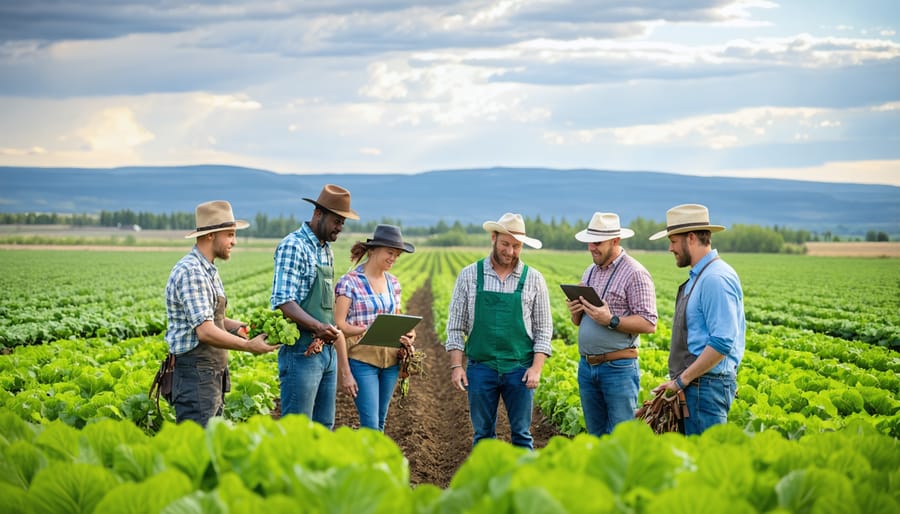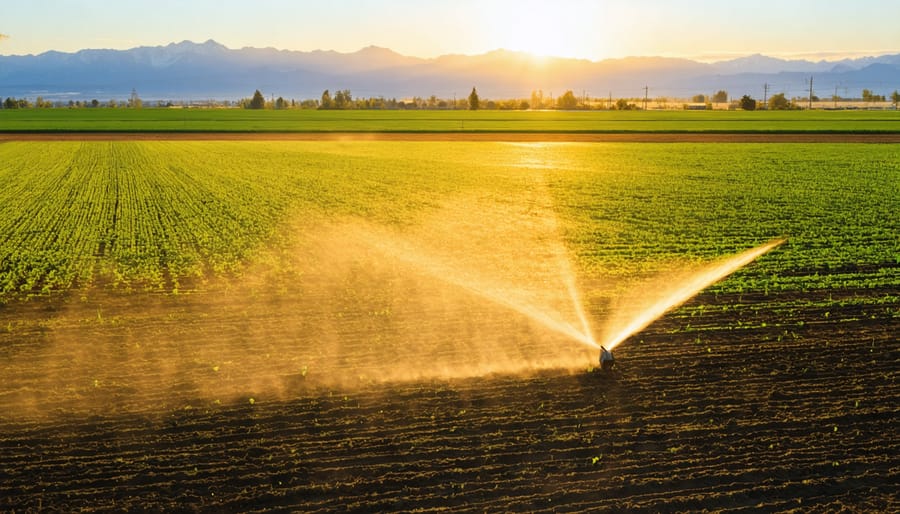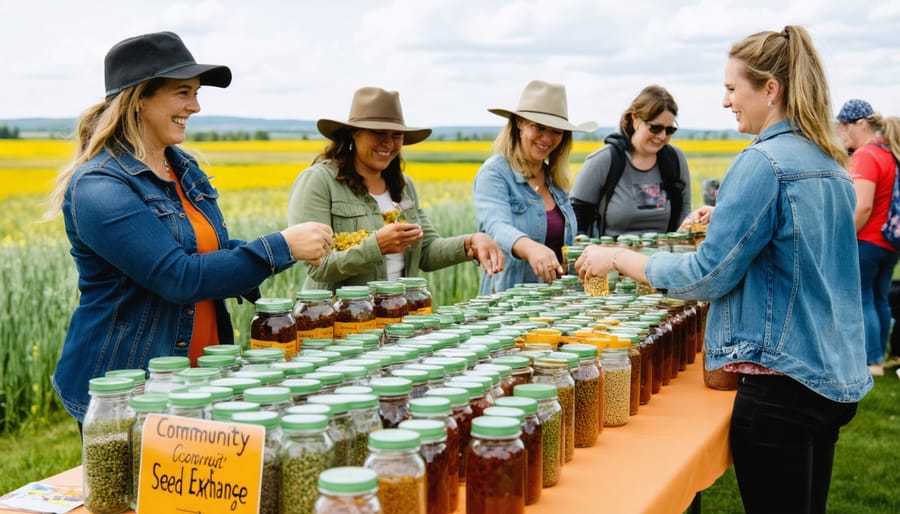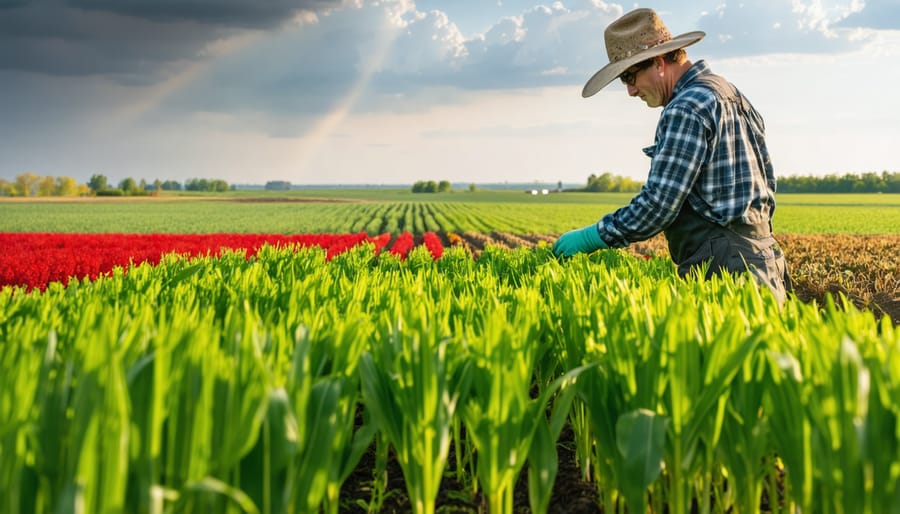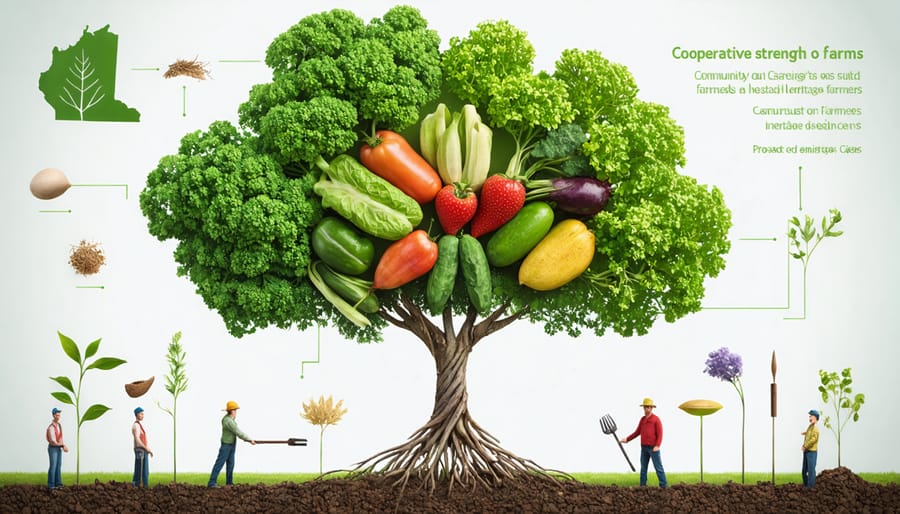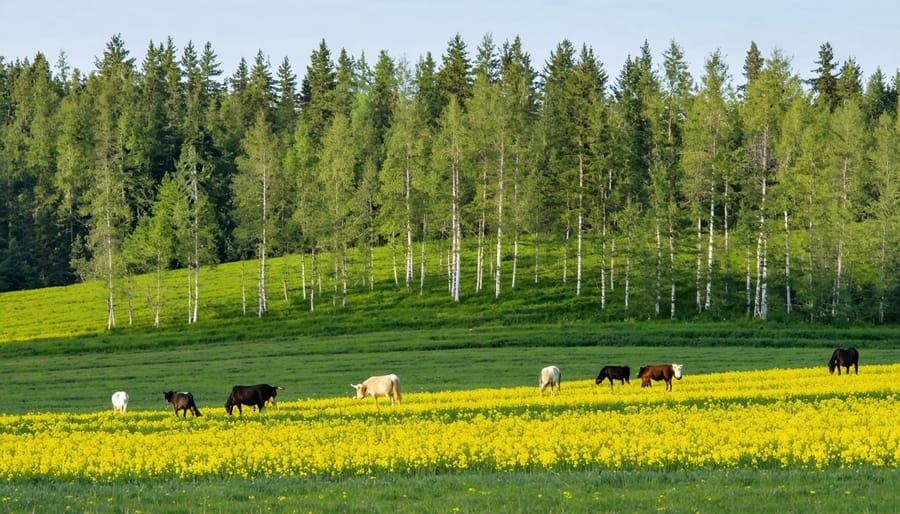Building thriving organic communities transforms individual farming operations into resilient agricultural networks. Alberta’s most successful collaborative farming initiatives demonstrate how shared knowledge, resources, and mutual support create exponential benefits for all participants. When farmers pool equipment, coordinate crop rotations, and establish collective marketing channels, production costs decrease while market access expands. Modern agricultural challenges demand community-based solutions – from tackling climate variability to accessing premium markets and preserving traditional farming wisdom. Through organized seed exchanges, collective soil health monitoring, and coordinated pest management strategies, Alberta’s organic farmers have built robust support systems that enhance both ecological and economic sustainability. These collaborative approaches have proven particularly effective in regions like Central Alberta, where neighboring organic operations have reduced input costs by 30% through equipment sharing and bulk purchasing programs while simultaneously increasing their market presence through unified branding initiatives.
The Power of Local Farming Networks
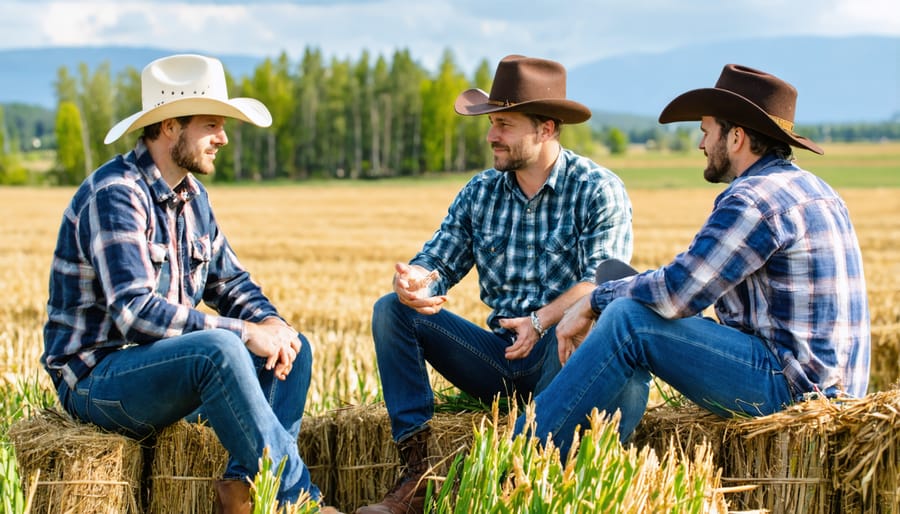
Knowledge Sharing Circles
In Alberta’s organic farming community, knowledge sharing circles have become vital hubs for exchanging sustainable agricultural practices. These informal gatherings, often hosted at different farms throughout the growing season, create opportunities for both experienced and novice farmers to learn from each other’s successes and challenges.
Local organic farmer Sarah Thompson hosts monthly meetings in Red Deer County, where farmers discuss everything from soil health management to pest control strategies. “These circles aren’t just about sharing information,” Thompson explains. “They’re about building relationships and creating a network of support for organic farmers that extends beyond the growing season.”
The Prairie Organic Grain Initiative has documented how these knowledge circles have helped farmers reduce costly mistakes and accelerate their learning curve. Through structured discussions and field demonstrations, participants share practical solutions for common challenges like weed management and crop rotation planning.
Many circles now incorporate digital tools, using WhatsApp groups and online forums to maintain year-round connections. This hybrid approach allows farmers to share time-sensitive information during crucial growing periods and organize impromptu gatherings when immediate challenges arise.
Successful knowledge circles typically meet every 4-6 weeks during peak season, with 10-15 participants per group. This intimate size ensures everyone has the opportunity to contribute while maintaining meaningful dialogue about region-specific farming practices.
Resource Pooling Initiatives
Across Alberta, farmers are discovering the power of pooling resources to enhance operational efficiency and reduce costs. The Pembina Valley Equipment Share Program serves as a shining example, where 15 organic farmers collectively purchased and share specialized equipment like flame weeders and mechanical cultivators. This initiative has helped members save an average of $25,000 each in equipment costs while ensuring optimal usage of machinery throughout the growing season.
In the Red Deer region, the Central Alberta Farm Cooperative demonstrates the benefits of collective purchasing power. Their bulk buying program for organic seeds and amendments has resulted in 20-30% cost savings for participating farmers. Members coordinate their orders seasonally, sharing transportation costs and securing better prices through volume discounts.
The Mountain View Harvest Co-op showcases how smaller farms can access expensive processing equipment through shared ownership. Their mobile grain cleaning unit rotates between 12 member farms, making professional-grade cleaning accessible to operations that couldn’t justify the investment individually.
These successful initiatives often start small but grow steadily. The key to their success lies in clear agreements about scheduling, maintenance responsibilities, and cost-sharing. Many groups use digital tools to coordinate equipment use and maintain transparent communication among members. Regular maintenance schedules and designated coordinators help ensure smooth operations and fair access for all participants.
Collaborative Solutions for Common Challenges
Community-Based Pest Management
Community-based pest management has emerged as a powerful solution for organic farmers across Alberta, proving that collective action yields better results than individual efforts. When neighboring farms coordinate their natural pest control strategies, they create wider ecological zones that effectively manage pest populations while supporting beneficial insects.
In the Red Deer River Valley, a group of twelve organic farmers demonstrated this approach’s success by implementing synchronized crop rotation and companion planting schedules. Their coordinated efforts reduced grasshopper damage by 60% compared to previous years, without using synthetic pesticides. The key to their success was maintaining consistent communication through monthly meetings and a shared digital platform for reporting pest sightings.
Strategic placement of habitat corridors across multiple properties has also shown remarkable results. Farmers in the Lacombe region collaborated to plant flowering hedgerows and establish beetle banks along property boundaries, creating continuous wildlife corridors that support natural predators. This network approach has helped maintain a healthy balance of beneficial insects across the entire farming community.
Knowledge sharing plays a crucial role in community pest management. Local farming groups organize regular workshops where experienced organic farmers share their observations and techniques with others. These sessions often feature practical demonstrations of methods like trap cropping and the use of beneficial nematodes, making it easier for newcomers to adopt these practices.
The Alberta Organic Producers Association reports that farms participating in community-based pest management programs experience 40% fewer severe pest outbreaks compared to those operating in isolation. This success has inspired more farming communities to adopt similar collaborative approaches, recognizing that pest management is more effective when approached as a shared responsibility.

Soil Health Partnerships
In Alberta’s farming communities, the partnership approach to soil health has revolutionized how we maintain and improve our agricultural lands. Through coordinated efforts, neighboring farms are joining forces to implement sustainable soil management practices that benefit entire regions.
The Mountain View Organic Collective, for instance, has established a shared composting facility where member farms contribute organic materials and receive high-quality compost in return. This initiative not only reduces waste but also ensures consistent soil amendment quality across participating farms. Members report a 30% reduction in individual composting costs and improved soil organic matter content within two growing seasons.
Crop rotation planning has taken on a community dimension, with farmers coordinating their planting schedules to maximize soil benefits across adjacent properties. The Prairie Soil Network, comprising 15 farms near Red Deer, coordinates rotation patterns to prevent pest cycles and enhance natural nitrogen fixation. Their collaborative approach has resulted in a 25% increase in soil nitrogen levels and reduced pest pressure across the network.
Regional soil testing programs have emerged as another successful partnership model. By pooling resources, farming communities can afford more comprehensive soil analyses and share the costs of soil health consultants. The resulting data helps create detailed soil improvement strategies that consider the interconnected nature of local ecosystems.
These partnerships extend beyond just sharing resources – they’re building knowledge networks. Monthly soil health workshops, mentorship programs, and collaborative research projects with agricultural colleges are helping spread innovative practices throughout the community. The success of these initiatives demonstrates how working together can accelerate the transition to healthier, more resilient agricultural soils.
Building Sustainable Market Access
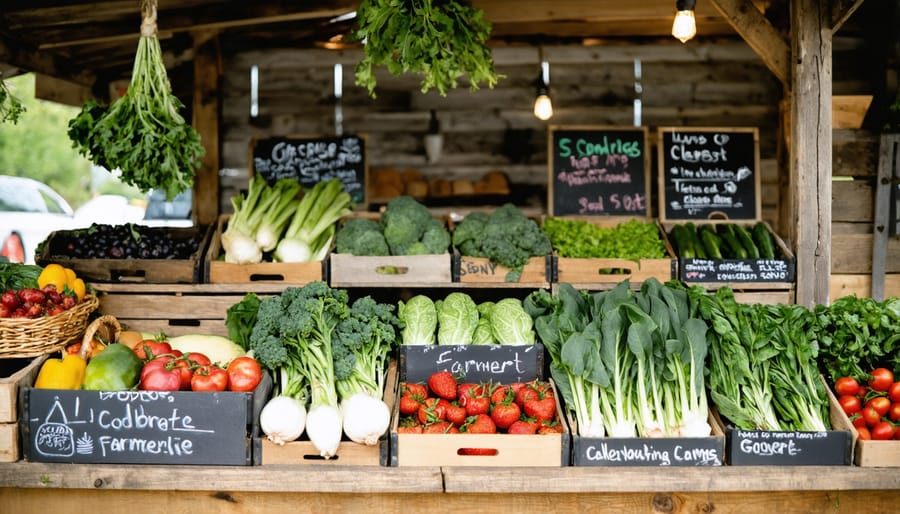
Farmer-Led Marketing Cooperatives
Alberta’s farming communities have seen remarkable success through organic marketing initiatives that prioritize collective strength over individual efforts. The Organic Box, established in Edmonton, demonstrates how small-scale farmers can leverage cooperative marketing to reach urban consumers effectively. Starting with just 12 family farms in 2010, the initiative now supports over 60 local producers and serves thousands of households across central Alberta.
In the Peace Country region, the Growing North Cooperative has transformed how local organic grain producers access markets. By pooling resources and sharing transportation costs, member farmers have reduced individual expenses by approximately 30% while expanding their market reach into British Columbia and Saskatchewan.
The Southern Alberta Organic Producers Association showcases another successful model, where 25 vegetable farmers coordinate crop planning and establish shared distribution channels. This coordination has led to more stable pricing and year-round supply contracts with major retailers, resulting in a 45% increase in member farm revenues over three years.
These success stories highlight key elements of effective farmer-led marketing: shared resource management, coordinated production planning, and collective bargaining power. The model continues to evolve, with newer initiatives incorporating digital platforms for real-time inventory management and consumer engagement, ensuring sustained growth for Alberta’s organic farming community.
Community-Supported Agriculture Programs
Community-Supported Agriculture (CSA) programs have become a cornerstone of collaborative farming in Alberta, with remarkable success stories emerging across the province. Local farmers are joining forces to create robust CSA networks that benefit both producers and consumers while strengthening regional food security.
Take the Prairie Harvest Partnership, a collective of six family farms near Red Deer, that pooled their resources to establish a comprehensive CSA program serving over 200 families. By coordinating their growing schedules and sharing distribution infrastructure, they’ve reduced individual operational costs by approximately 30%.
“Working together means we can offer our members greater variety and consistency,” explains Sarah Thompson, a founding member. “When one farm has a challenging season with certain crops, others can fill the gap, ensuring our members always receive quality produce.”
Successful CSA collaborations typically involve:
– Shared delivery systems and pickup locations
– Coordinated crop planning among participating farms
– Combined marketing efforts and member management
– Collective risk management strategies
– Resource sharing for equipment and storage
Many Alberta CSAs have implemented innovative solutions like rotating management responsibilities and developing shared online platforms for member communication. Some programs have expanded beyond vegetables to include eggs, meat, and honey through strategic partnerships with local producers.
The key to success lies in clear communication and formal agreements between participating farms, ensuring everyone understands their responsibilities and benefits from the collaboration.
Future Growth Through Collaboration
As we look to the future of collaborative farming in Alberta, exciting opportunities are emerging that promise to reshape our agricultural landscape. Digital platforms are increasingly connecting farmers across vast distances, enabling real-time knowledge sharing and problem-solving. These virtual communities complement traditional face-to-face interactions, allowing farmers to collaborate regardless of geographical barriers.
The rise of precision agriculture technology presents new possibilities for data sharing among farming communities. By pooling information about soil health, weather patterns, and crop yields, farmers can make more informed decisions while contributing to a broader understanding of regional agricultural patterns. This collaborative approach to data management could revolutionize how we approach sustainable farming practices.
Equipment sharing programs are expected to expand significantly, with new models incorporating smart scheduling systems and preventive maintenance tracking. These innovations will make resource sharing more efficient and accessible, particularly benefiting smaller operations that may not have the capital for extensive equipment purchases.
Mentorship programs are evolving to include cross-generational knowledge transfer, combining traditional farming wisdom with modern sustainable practices. Young farmers bringing fresh perspectives on technology and sustainability can work alongside experienced producers who understand the nuances of local growing conditions.
Climate change adaptation will likely drive increased collaboration among farmers. Collective approaches to water management, soil conservation, and pest control will become increasingly important. Community-based climate resilience strategies are already emerging, with farmers working together to implement sustainable solutions at a watershed or regional level.
Looking ahead, we can expect to see more formalized partnerships between organic farmers and research institutions. These collaborations will help bridge the gap between academic research and practical application, leading to more effective and sustainable farming methods.
The future of farming in Alberta lies in our ability to work together, share resources, and adapt to changing conditions as a community. By embracing these collaborative opportunities, we can build a more resilient and sustainable agricultural sector for generations to come.
The power of collaborative community in organic farming extends far beyond individual farm boundaries, creating a resilient and sustainable agricultural future for Alberta and beyond. Through shared knowledge, resources, and support networks, farmers who embrace collaborative approaches consistently report higher yields, better problem-solving capabilities, and increased market access.
The benefits we’ve explored throughout this article – from equipment sharing programs to collective marketing initiatives – demonstrate that success in organic farming isn’t a solitary journey. When farmers work together, they create stronger local food systems, reduce operational costs, and build more resilient farms that can weather both environmental and economic challenges.
Now is the perfect time to get involved in your local farming community. Whether you’re an experienced organic farmer or just starting your transition, there are numerous ways to participate. Consider joining a local organic farming association, attending community workshops, or initiating equipment-sharing arrangements with neighboring farms. Even small steps toward collaboration can lead to significant positive changes for your operation.
Remember, every successful collaborative initiative started with farmers just like you taking that first step toward working together. The future of organic farming in Alberta depends on our willingness to share, learn, and grow as a community. Reach out to local farming organizations, connect with neighboring producers, and become part of the collaborative movement that’s transforming Canadian agriculture.
Together, we can build a more sustainable and prosperous farming future for generations to come.

